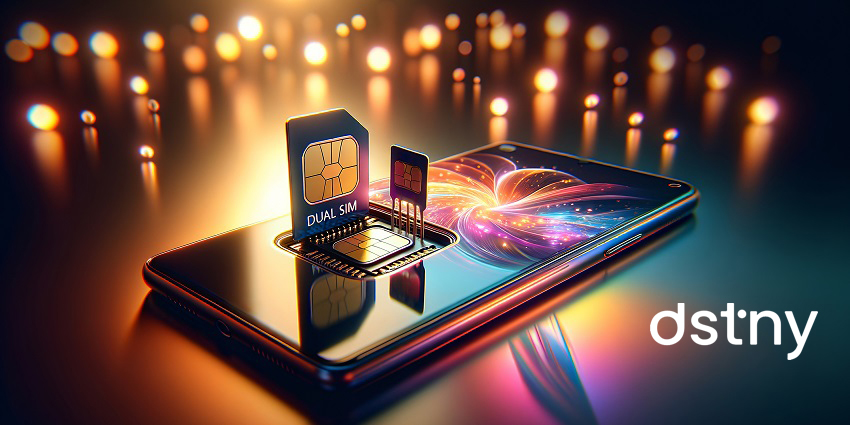Two into one does go.
One mobile, two separate numbers: the latest phase of the cost-saving, convenience-enhancing business communications evolution.
That’s Fixed Mobile Convergence (FMC) – a business number and a personal number on the same mobile device. Separate contacts; separate calling and messaging functionality; separate billing; and seamless switching between each.
For businesses and individuals, the benefits are multiple. The in-palm user convenience is obvious, however the economics are perhaps more surprising. Lower landline costs, lower hardware costs, reduced management costs. Also, enhanced reputation thanks to the slick, professional nature of employees being able to make and receive business calls whenever they need to and wherever they are.
The benefits are also significant for Managed Service Providers for whom the mobile telephony market may, for a long time, have looked devoid of fresh opportunity. Thanks to FMC, upselling business mobile account holders a second SIM is the kind of second wind that can boost bottom line and strengthen customer retention.
As is always the case, picking the right vendor is key.
“It’s all about integrating users’ mobile phones with organisations’ in-house telephony, whether that is via a traditional hard-wired system or a modern cloud-powered unified communications platform,” says Mark Herbert, Unified Communications and voice integration specialist at Dstny for Service Providers, whose ‘Converge’ FMC solution is a no-brainer for growth-hungry MSPs.
“Years ago, FMC 1.0 was the placing of basic call forwarding onto a PBX. When users were out of the office their calls were diverted, but they had to return those calls from their mobile, which looked unprofessional. More recently, FMC 2.0 replicated PBX functionality onto a downloadable softphone app, but apps depend on available data and can be unreliable.
“Today’s FMC 3.0 leverages the mobile phone’s native dialer via two SIM cards – one personal and one business. A user’s personal mobile can now also have a business SIM electronically added by email or, alternatively, a business mobile provided by an employer can have a personal SIM electronically added by email. The phone now has two brains and the switching between both is done automatically on a per-call basis.”
Brilliantly, mobile business calls are processed in exactly the same way as they are when they are made or received via user organisations’ PBX. Call recording or any other compliance or security functionality that is baked-in to the system is automatically replicated on the mobile device. For example, in the financial services sector, that FMC functionality is business-critical.
FMC is also a cost-effective replacement for Digital Enhanced Cordless Telecommunications (DECT) where, for example, workers on large sites or factories who do not have access to desk phones must be provided with costly, high-maintenance cordless devices in order to communicate with colleagues and customers.
Dstny calls these ‘mega niche’ opportunities for MSPs – apparently niche use cases that are in high demand in volume terms.
“IT departments in those kinds of businesses love FMC,” says Herbert. “They can deliver a new business extension by e-mail, they don’t have to install an app that needs device management software and security, and there is no need for hardware and cabling. And they also get a single point of consolidated management of all their calls. It makes the whole move to the cloud so much more simple.”
The end of the desk phone? Well, quite possibly. Indeed, Dstny for Service Providers recently published a customer case study which revealed how, in Scandinavia, 92% of business extensions don’t end up on a desk but are instead installed directly onto mobile phones.
“The case study was entitled ‘How the Nordics Killed the Desk Phone’”, says Herbert. “So yes, I think FMC is simplifying and redrawing the whole UCaaS landscape. Users can do extension dialling, they can go to hold and transfer of calls; all the things they would generally do on a desk phone, they can do within the mobile dialer.”
For Dstny’s MSP partners, it is a big opportunity with a low barrier of entry.
“We ensure our partners are extremely well set up to launch this solution,” says Herbert.
“We have all kinds of guides and marketing collateral designed to help them be successful. It’s something new and revolutionary and simple for them to talk to their customers about. Also, there are no geographical restrictions.
“Increased mobility has been forced on their end user customers over the last few years and many are still in the problem-solving phase. MSPs can go to them with an FMC solution that is relatively low cost and straightforward. Those customers also get to leverage capacity in their voice network that may have gone a little quiet due to the rise of messaging. They can start capitalising on that asset again. From the MSPs’ perspective, it all needs consulting and managing and setting up so there is still a big role for them. It’s something they can deliver quickly and without large capital expense. There’s no big training programme, and they don’t have to invest in demo kit.”
Who said the SIM market is saturated? Everyone has a mobile – now it appears many need two in one.
That’s quite an upsell opportunity..!
To learn more about how Dstny for Service Providers can help your and your customers’ businesses benefit from FMC, click here.







